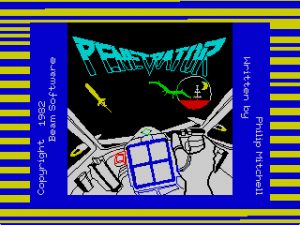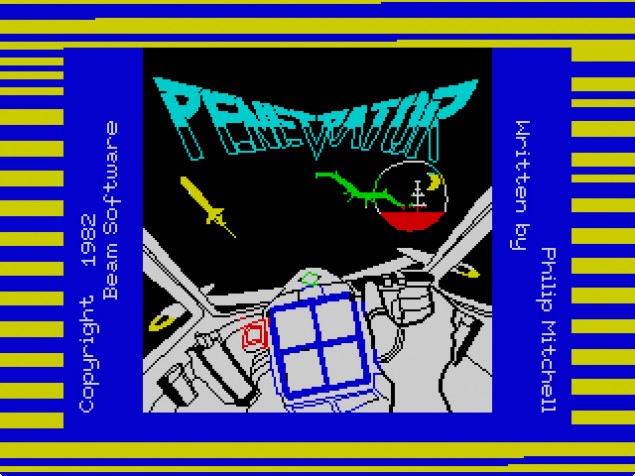Memories of Melbourne House from British game players of the 1980s

[ 1 comment ]
In a second post on the relationship between British and Australian computer game scenes in the 1980s, we turn to two game developers who reminisce about playing Beam Software and/or Melbourne House games during this time. As has been discussed in previous Play it Again blogs, the relationship between UK and Australian microcomputing can be seen through the publisher Melbourne House and the development studio Beam Software. The Melbourne House and the Tyranny of Distance post in particular details how the Spectrum and the ‘Horace games’ cemented “the Australian companies place in the history of British computing”.
The rest of this blog post details a conversation with programmers Steve Clark and Jas Austin as they remember playing Melbourne House/Beam Software games on their Spectrums, in particular Penetrator and The Hobbit.
Alison Gazzard: Would you both like to introduce yourselves?
Jas Austin: My name is Jas Austin. I’ve worked as a professional game designer and programmer since the early 80’s. I’m also an avid game player, and have owned the majority of gaming platforms through the ages, which I enjoy playing all styles of games on.
Steve Clark: My name’s Steve Clark, and I’ve been a professional games programmer for the past 22 years. These days I work mainly on mobile games for Origin8 (most recently on Transport Tycoon for the iOS and Android), and historically have worked on most consoles from the Super Nintendo onwards.
AG: Do you remember when you bought your first Spectrum?
JA: Ah, yes. I remember it well. I can’t recall the exact date, but it would have been close to the UK launch during 1982. Previously I owned a ZX81, which I managed to sell for a decent price. Using this money I picked up a Spectrum. I remember waiting excitedly outside our local WH Smiths before opening time in the hope of picking one up. Turned out I was the only person interested in one at that time. So managed to get one easily enough.
SC: My first Spectrum was given to my brother and myself as a Christmas present in December 1983. Unusually for our Christmas presents, we were allowed to unwrap it on Christmas Eve. In the run-up to Christmas, we had each chosen a game for it – I chose ‘Rommel’s Revenge’ (a battlezone clone, and my brother chose ‘Manic Miner’) – and so that we would be able to ‘play’ on Christmas Day, my dad decided we could have it early and use Christmas Eve to go through the tutorial ‘Horizons’ tape to learn how the computer worked. So that first evening we went through the whole tape, from how the multiple keywords were accessed, to playing ‘Thru The Wall’ and watching ‘Bubblesort’ (a technique I still use when programming today).
AG: Which games did you play that were developed/published by Beam Software/Melbourne House?
JA: I played many of their games. Including… The Hobbit, Hungry Horace, Horace Goes Skiing, Horace and the Spiders, Penetrator, Sherlock, Starion, Mugsy, Throne of Fire, The Way of the Exploding Fist, Rock & Wrestle, and finally Gyroscope, I particularly remember Gyroscope it because it was developed by Catalyst coders and I was working with them at the time. And the guys that worked on it were friends of mine.
SC: I can distinctly remember playing ‘The Hobbit’ with my brothers, and trying all the weird and wonderful ways to get the characters to do what I wanted – attempting to carry ‘Thorin’ (who’d more often than not just sit down and sing about gold) and ‘smash door’ in the cell.
I also enjoyed the amazing ‘Scramble’ clone ‘Penetrator’.
AG: Do you remember playing them because they were developed/published by Beam Software/Melbourne House?
JA: I was certainly aware of them being Beam Software/Melbourne house games. And on the whole, they had a high quality output. But personally I would have judged each game individually. Review score, interest in the genre etc. And as with other publishers, I was quite aware of the actual developers. So I saw ‘Throne of Fire’ as a Mike Singleton game first and a Melbourne House game second.
SC: No, I mostly bought and played games based on the games themselves rather than the developers. The one exception to that would be British game company, Durrell as their games were consistently amazing – from ‘Turbo Esprit’ (possibly my favourite Spectrum game), ‘Saboteur’, ‘Scuba Dive’ – a whole catalogue of outstanding software.
AG: Thinking about Penetrator in more detail, do you remember when you first played the game?
JA: I could not say exactly when I first played Penetrator, but it would have been around the time of release. And it would have been in my bedroom at my parents’ house, which is where I had my trusty old Spectrum set up.
SC: I remember playing it first when my brother brought it home. On loading it greeted me with screeching sirens, and a happy ‘doo-do doo’ tune when starting the game. From the first play it had me hooked, though the firing/launching missiles always felt a little indeterminate.
AG: Did you both like the game, and why?
JA: I thought the game was superb. Definitely the best version of a Scramble style game. Even though the background graphics were kept simple. At the time, it was very unusual to see a full screen game that had smooth scrolling. From a programming point of view I was very impressed with its seemingly pixel perfect collision detection. Its gameplay felt spot on too. Sure it was very tough, but also fair. Whenever I died I felt it was my fault and not the games. There was also the tense finale, which was clearly inspired by the ‘Star Wars trench scene’ — where you had just one chance to hit the final target with a single bomb. If you failed it meant death. But success was rewarded by a firework display in your honour.
SC: I loved it. I wasn’t a big fan of ‘Scramble’ in the arcade, but having this version at home meant I could get better over time without putting lots of coins into a very hard game.
The idea of floor and ceilings to avoid, the caverns in later levels added a nice variation, and I remember feeling that when I lost it wasn’t because the game ‘had cheated’ (which some often felt like), so the desire to get further remained.
AG: Do you remember using any particular hints or tricks? What were they?
SC: It was the first game I played where you could edit the levels, and I remember the feeling of cheeky pleasure on flatting the world to make life easier, and the sense of cheating that came from selecting level 5 for training when you were only allowed 1-4 (found by thinking ‘I wonder if there are more levels…’) Initially using the level editor was to make the game a lot easier for example, levels 1-4 completely flat top and bottom (that was saved and loaded back in a few times), but my attempts at creating other levels weren’t saved, though I recall a few nice caverns I made which would have been great to replay again.
AG: Similarly, thinking about The Hobbit, do you remember where you first played that?
JA: This would have been the same as Penetrator, around the time of release, in my bedroom.
SC: I remember going out as a family to Croydon and buying ‘The Hobbit’. It was very much my brother’s choice as he had read Tolkein’s books and wanted to play. I’m glad he did, as the game was amazing.
AG: What was it that you liked about The Hobbit and why?
JA: Being a fan of adventures games and Tolkien, I was very interested to play The Hobbit. And see how they would introduce graphics into the classic text adventure format. I’m happy to say it didn’t disappoint. I seem to recall the story followed the book closely. But it was the graphics that made it stand out. While somewhat crude. All were drawn using line draws and flood fills, no doubt the only way to fit them into the limited memory of the Spectrum. They really added to the atmosphere of the game. The sense of achievement in solving the puzzles to unlock a new location, and to see it slowly revealed on screen for the first time was tremendous.
SC: The game was the first adventure I remember that created in my head (and on screen) vivid locations, and I had a sense that you were the character in the game – reaching further into the game, avoiding being eaten by the trolls, and a range of instructions made it fun to explore and learn.
AG: Do you remember any particular hints or tricks that you used when playing the game?
JA: As the Hobbit was released way before the Internet and easy to find ‘walkthroughs’ this was a game that was very easy to get completely stuck on. I would find myself thinking through its puzzles while not actually playing the game. It was also a great game for encouraging discussions amongst my friends that were also playing it. We would chat about the puzzles we were stuck on, and even boast about solving sections the others hadn’t.
SC: I think most of the things learnt during the game were trial and error – how to get out of the dungeon, how to reach the gold and so on. Thinking about it, I’ve never actually completed the game, so that may be a game to play again soon!
Thanks to both Steve Clark and Jas Austin for their time and memories!
Alison Gazzard is a Lecturer in Media Arts at the Institute of Education in the UK currently researching British microcomputing in the 1980s. She learnt to program on the BBC Micro.


The thing I remember about Penetrator was both its opening fireworks display, and the fact it had crisp, smooth graphics. Obviously it was also a lot of fun – and I also remember vividly buying it from a very small computer store on Auckland’s North Shore…
Great times!